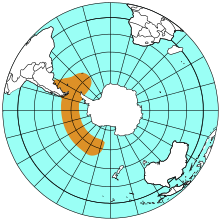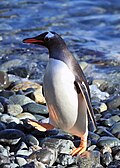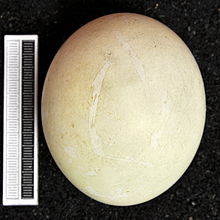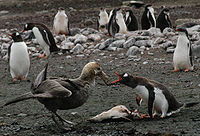
Penguins are a group of aquatic flightless birds from the family Spheniscidae of the order Sphenisciformes. They live almost exclusively in the Southern Hemisphere: only one species, the Galápagos penguin, is found north of the Equator. Highly adapted for life in the ocean water, penguins have countershaded dark and white plumage and flippers for swimming. Most penguins feed on krill, fish, squid and other forms of sea life which they catch with their bills and swallow whole while swimming. A penguin has a spiny tongue and powerful jaws to grip slippery prey.

The Adélie penguin is a species of penguin common along the entire coast of the Antarctic continent, which is the only place where it is found. It is the most widespread penguin species, and, along with the emperor penguin, is the most southerly distributed of all penguins. It is named after Adélie Land, in turn, named for Adèle Dumont d'Urville, who was married to French explorer Jules Dumont d'Urville, who first discovered this penguin in 1840. Adélie penguins obtain their food by both predation and foraging, with a diet of mainly krill and fish.

The sheathbills are a family of birds, Chionidae. Classified in the wader order Charadriiformes, the family consists of one genus, Chionis with two species. They breed on subantarctic islands and the Antarctic Peninsula, and the snowy sheathbill migrates to the Falkland Islands and coastal southern South America in the southern winter; they are the only bird family endemic as breeders to the Antarctic region. They are also the only Antarctic birds without webbed feet.

The emperor penguin is the tallest and heaviest of all living penguin species and is endemic to Antarctica. The male and female are similar in plumage and size, reaching 100 cm (39 in) in length and weighing from 22 to 45 kg. Feathers of the head and back are black and sharply delineated from the white belly, pale-yellow breast and bright-yellow ear patches.

The chinstrap penguin is a species of penguin that inhabits a variety of islands and shores in the Southern Pacific and the Antarctic Oceans. Its name stems from the narrow black band under its head, which makes it appear as if it were wearing a black helmet, making it easy to identify. Other common names include ringed penguin, bearded penguin, and stonecracker penguin, due to its loud, harsh call.

The southern rockhopper penguin is a species of rockhopper penguin, that is sometimes considered distinct from the northern rockhopper penguin. It occurs in subantarctic waters of the western Pacific and Indian Oceans, as well as around the southern coasts of South America.

The king penguin is the second largest species of penguin, smaller, but somewhat similar in appearance to the emperor penguin. There are two subspecies, A. p. patagonicus and A. p. halli; patagonicus is found in the South Atlantic and halli in the South Indian Ocean and at Macquarie Island.

The macaroni penguin is a species of penguin found from the Subantarctic to the Antarctic Peninsula. One of six species of crested penguin, it is very closely related to the royal penguin, and some authorities consider the two to be a single species. It bears a distinctive yellow crest that resembles macaroni, from which its name is derived. Its face and upperparts are black and sharply delineated from the white underparts. Adults weigh on average 5.5 kg (12 lb) and are 70 cm (28 in) in length. The male and female are similar in appearance; the male is slightly larger and stronger with a relatively larger bill. Like all penguins, it is flightless, with a streamlined body and wings stiffened and flattened into flippers for a marine lifestyle.

The yellow-eyed penguin, known also as hoiho, is a species of penguin endemic to New Zealand.

The genus Pygoscelis ("rump-legged") contains three living species of penguins collectively known as "brush-tailed penguins".

The rockhopper penguins are three closely related taxa of crested penguins that have been traditionally treated as a single species and are sometimes split into three species.

The brown skua, also known as the Antarctic skua, subantarctic skua, southern great skua, southern skua, or hākoakoa (Māori), is a large seabird that breeds in the subantarctic and Antarctic zones and moves further north when not breeding. Its taxonomy is highly complex and a matter of dispute, with some splitting it into two or three species: Falkland skua, Tristan skua, and subantarctic skua. To further confuse, it hybridizes with both the south polar and Chilean skuas, and the entire group has been considered to be a subspecies of the great skua, a species otherwise restricted to the Northern Hemisphere.

The southern giant petrel, also known as the Antarctic giant petrel, giant fulmar, stinker, and stinkpot, is a large seabird of the southern oceans. Its distribution overlaps broadly with the similar northern giant petrel, though it overall is centered slightly further south. Adults of the two species can be distinguished by the colour of their bill-tip: greenish in the southern and reddish in the northern.

The striated caracara or Forster's caracara is a Near Threatened bird of prey of the family Falconidae, the falcons and caracaras. It is found in Argentina, Chile, and the Falkland Islands. In the Falklands it is known as the Johnny rook, probably named after the Johnny penguin.

The Antarctic tern is a seabird in the family Laridae. It ranges throughout the southern oceans and is found on small islands around Antarctica as well as on the shores of the mainland. Its diet consists primarily of small fish and crustaceans. It is very similar in appearance to the closely related Arctic tern, but it is stockier, and it is in its breeding plumage in the southern summer, when the Arctic tern has shed old feathers to get its non-breeding plumage. The Antarctic tern does not migrate like the Arctic tern does, but it can still be found on a very large range. This tern species is actually more closely related to the South American tern.
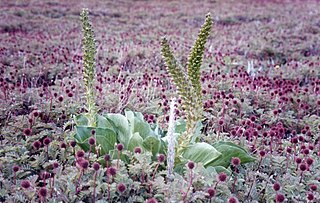
The Southern Indian Ocean Islands tundra is a tundra ecoregion that includes several subantarctic islands in the southern Indian Ocean.

The eastern rockhopper penguin, also known as the tawaki piki toka, is a crested penguin with yellow crest feathers. It is a subspecies of the southern rockhopper penguin found in subantarctic regions and the Indian Ocean. It is one of the smallest crested penguins and has distinctive pink margins around its bill.
Gourdin Island is the largest island (124 ha) in a group of islands and rocks 2 km (1 nmi) north of Prime Head, the northern tip of the Antarctic Peninsula. It was discovered by a French expedition, 1837–40, under Captain Jules Dumont d'Urville, and named by him for Ensign Jean Gourdin of the expedition ship Astrolabe. The island was reidentified and charted by the Falkland Islands Dependencies Survey in 1945–47.
